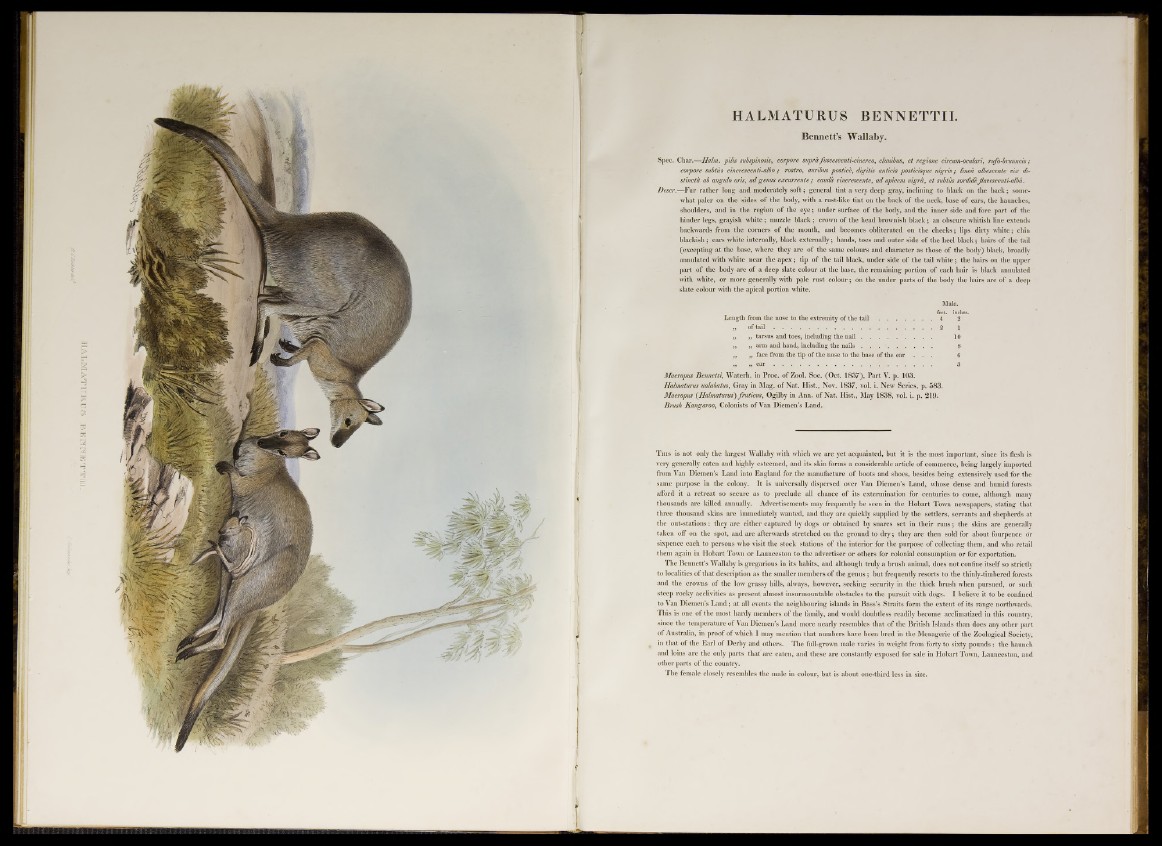
M ia « S flM IU JL VM T tV H
HALMATURUS BENNETTI I .
Bennett’s Wallaby.
Spec. Char.— Halm, pilis subspinosis, corpore supra fuscescenti-cinereo, clunibus, et regione circum-oculari, rufo-brunneis;
corpore subtus cinerescenti-albo; rostro, auribus postice, digitis anticis posticisque nigris; lined albescente vuo distinct
d ab angulo oris, adgenas excurrente ; caudu cinerescente, ad apicem nigra, et subtus sordide Jlanescenti-ulbd.
Descr.—Fur rather long and moderately so ft; general tint a very deep gray, inclining to black on the back; somewhat
paler on the sides o f the body, with a rust-like tint on the back o f the neck, base o f ears, the haunches,
shoulders, and in the region o f the ey e; under surface o f the body, and the inner side and fore part o f the
hinder legs, grayish white; muzzle black; crown of the head brownish black; an obscure whitish line extends
backwards from the corners o f the mouth, and becomes obliterated on the cheeks; lips dirty white; chin
blackish; ears white internally, black externally; hands, toes and outer side o f the heel black; hairs o f the tail
(excepting at the base, where they are o f the same colours and character as those of the body) black, broadly
annulated with white near the apex; tip o f the tail black, under side of the tail white; the hairs on the upper
part o f the body are o f a deep slate colour at the base, the remaining portion o f each hair is black annulated
with white, or more generally with pale rust colour; on the under parts o f the body the hairs are o f a deep
slate colour with the apical portion white.
Male.
feet, inches.
Length from the nose to the extremity of the t a i l 4 2
' „ of t a i l ........................................................................................................2 1
„ „ tarsus and toes, including the n a i l ................................................... 10
,, „ arm and hand, including the nails . . . •................................... 8
,, ,, face from the tip of the nose to the base of the ear . . . 6
,, ,, e a r ......................................................................................................... 3
Macropus Bennetti, Waterh. in Proc. o f Zool. Soc. (Oct. 1837), Part V. p. 103.
Halmaturus ualabatus, Gray in Mag. o f Nat. Hist., Nov. 1837, vol. i. New Series, p. 583.
Macropus {Halmaturus) fruticus, Ogilby in Ann. o f Nat. Hist., May 1838, vol. i. p. 219.
Brush Kangaroo, Colonists o f Van Diemen’s Land.
T his is not only the largest Wallaby with which we are yet acquainted, but it is the most important, since its flesh is
very generally eaten and highly esteemed, and its skin forms a considerable article o f commerce, being largely imported
from Van Diemen’s Land into England for the manufacture o f boots and shoes, besides being extensively used for the
same purpose in the colony. It is universally dispersed over Van Diemen’s Land, whose dense and humid forests
afford it a retreat so secure as to preclude all chance o f its extermination for centuries to come, although many
thousands are killed annually. Advertisements may frequently be seen in the Hobart Town newspapers, stating that
three thousand skins are immediately wanted, and they are quickly supplied by the settlers, servants and shepherds at
the out-stations: they are either captured by dogs or obtained by snares set in their runs; the skins are generally
taken off on the spot, and are afterwards stretched on the ground to dry; they are then sold for about fourpence o'r
sixpence each to persons who visit the stock stations o f the interior for the purpose o f collecting them, and who retail
them again in Hobart Town or Launceston to the advertiser or others for colonial consumption or for exportation.
The Bennett’s Wallaby is gregarious in its habits, and although truly a brush animal, does not confine itself so strictly
to localities o f that description as the smaller members o f the g enus; but frequently resorts to the thinly-timbered forests
and the crowns o f the low grassy hills, always, however, seeking security in the thick brush when pursued, or such'
steep rocky acclivities as present almost insurmountable obstacles to the pursuit with dogs. I believe it to be confined
to Van Diemen’s Land; at all events the neighbouring islands in Bass’s Straits form the extent o f its range northwards.
This is one o f the most hardy members of the family, and would doubtless readily become acclimatized in this country,
since the temperature o f Van Diemen’s Land more nearly resembles that o f the British Islands than does any other part
o f Australia, in proof o f which I may mention that numbers have been bred in the Menagerie o f the Zoological Society,
in that o f the Earl o f Derby and others. The full-grown male varies in weight from forty to sixty pounds: the haunch
and loins are the only parts that are eaten, and these are constantly exposed for sale in Hobart Town, Launceston, and
other parts o f the country.
The female closely resembles the male in colour, but is about one-third less in size.